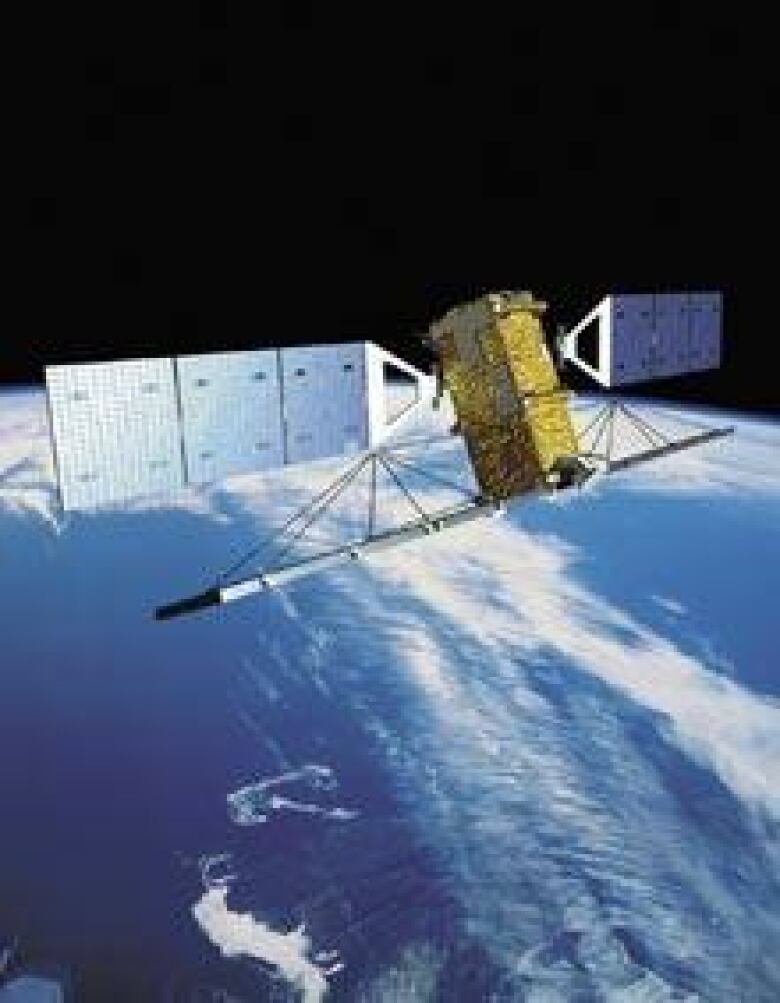Flying blind
A lack of government vision is hurting Canada's space industry, observers say
Hailed as a triumph for Canadian sovereignty, the federal government's decision to block the proposed sale of key units of MacDonald, Dettwiler and Associates Ltd. Canada's leading space business to an American firm could signal a turning point for Canada's space industry.

"We're in this waiting period, and no one has a sense of where things are headed," said Andrew Eddy, a former manager at the Canadian Space Agency who now heads the aerospace think tank Athena Global.
"What we need is a top-down national space policy."
Eddy's sentiment is one echoed by many in the industry, including former CSA head Marc Garneau and John Keating, president of space hardware manufacturer COM DEV. Industry insiders met in Montreal this week at a conference organized by the Canadian Aeronautics and Space Institute to discuss Canada's future space priorities, including what direction the government and industry should take.
But the elephant in the room remains the uncertain situation of Richmond, B.C.-based MacDonald, Dettwiler and Associates (MDA). The company wants to sell its space division, which includes Canadarm, Dextre and the Radarsat-2 satellite, to Minneapolis-based Alliant Techsytems, or ATK, a major U.S. defence contractor.
Sale still in limbo
MDA had argued the sale was necessary to ensure its space and satellite business could thrive, arguing it needed access to the U.S. market in the absence of consistent work in Canada.
The company's shareholders had overwhelmingly approved the deal, but critics of the sale, including Garneau, had asked Industry Minister Jim Prentice to block it, saying it amounted to a handing over of Canadian taxpayer-funded technology to the U.S. and, in the case of Radarsat-2, would give away technology designed to protect Canada's sovereignty.
'What we need is a top-down national space policy.' Former Canadian Space Agency manager Andrew Eddy
Prentice blocked the $1.3-billion sale, saying the deal did not provide a "net benefit" for Canada under the Investment Canada Act.
ATK has until May 8 to state its case for getting the sale approved, though the company could seek an extension of that deadline. ATK representatives have already met with government officials. Paul Cooper, vice-president for strategic development at MDA, told the Canadian Press at the Montreal conference Tuesday that his company was seeking to do the same.
The impact of the government decision, should the two companies fail to make their case, could have a ripple effect on Canada's space industry, as MDA accounts for about half of the contracts granted by the Canadian Space Agency and is by far the largest Canadian-owned maker of space technology.
But Eddy thinks it may be too late for the government to reverse course.
"They've painted themselves into a corner," he said.
The question now, he says, is what will the government do to ensure companies like MDA have enough business to thrive.
Canada losing ground in space: analysts
Canada's space industry is in a prime position to take advantage of the attention it received during the MDA-Alliant debate, says Keating, the president of Cambridge, Ont.-based COM DEV, but the government needs to seize the moment.
"Canada has stumbled in the dark for several years now," he said. "I think that this whole episode with MDA and ATK has woken people up to the fact that we have something really quite extraordinary here, and we should be proud of it and invest in it."
That investment has been lacking of late, says Keating.
Eddy's Athena Global conducted a strategic report in 2006 for the industry that found Canada's space budget was the lowest of all G8 nations, both in absolute terms and relative to its GDP. Canada's investment also declined more than any other G8 nation in recent years, dropping from 0.037 per cent of GDP in 1995 to 0.022 per cent in 2005.
And while Canada's investment has declined, other nations have taken a more active interest in their space programs.
A report published in April 2008 by U.S.-based technology consultancy Futron ranked Canada sixth in space competitiveness, behind recent entrants China and India, as well as mainstays Russia, Europe and the United States.
Advisory committee to look at space agency
The federal government has acted to address its perceived lack of direction in the space industry this year, announcing a call for applications to join the astronaut corps and the creation of a four-person advisory committee to look into the future role of the Canadian Space Agency.

Focusing on the manned space program would be a mistake, he said, particularly since the U.S. space industry is in a state of flux as it transitions from the retiring space shuttle program to future missions to the Moon and Mars.
"The manned space program shouldn't be what's defining the industry," said Eddy. "We're a small player, and we can't be the ones leading future missions."
Few in the scientific community want the country to focus on operations like the expensive International Space Station, says UBC astronomer Jaymie Matthews.
"There are not many scientists who are huge fans of the ISS," he said. "As a platform for science, it has been terrible."
But if one good thing has come from the project, he said, it's been the robotic innovations of companies like MDA.
The agency would get more bang for its buck if it focused on unmanned spacecraft and satellites, said Matthews, the principle scientist for the CSA's MOST project, a suitcase-sized satellite that has gained international attention for its ability to look for planets outside our solar system.
He said a good example of this is the MOST telescope or another project currently in development, the Near Earth Orbit Surveillance Satellite (NEOSSAT), which will be able to detect and track Earth-orbiting objects and asteroids and has a modest budget of $9.4 million.
A project like NEOSSAT could compliment, rather than compete with, the larger ambitions of nations like the U.S. looking to outer space as a source of natural resources.
"If you want to go with a shovel and dig up precious metals on asteroids, then you have to learn more about asteroids," said Matthews. "That's where NEOSSAT comes in. We're prospecting."
Micro-satellites seen as area of growth
Canadian companies have a built-in competitive advantage in optical, radar and other sensor technology, Keating says, and micro-satellites like NEOSSAT are one of a number of ways the companies can distinguish themselves.

"Now the Americans [are talking] about operation response in space, where they want people to build small micro-satellites and deploy them very quickly for all sorts of reasons. So, who's going to do that? Canadian companies, with a bit of support from government, could readily create a capability that could be world-beating in that area," Keating said.
Eddy agrees promoting satellite technology should be part of any Canadian mandate, and the focus should be on earth-observation satellites like Radarsat-2.
"We need to come up with a mission that addresses the needs of the country and the world, and those needs include environmental and Arctic monitoring. This is an area where we should be at the forefront," he said.
Ironically, Alliant vice-president Steve Cortese told a House of Commons committee that the company planned to use the technology of Radarsat-2 to build a fleet of similar satellites, in part to meet U.S. demand for next-generation satellites.
"Alliant sees Radarsat-2 as a very valuable asset and thought that it gave them a competitive advantage," said Eddy. "MDA, if they were creative, could be doing this, too."
MDA has already begun work on one such satellite expected to launch in 2010. Dubbed Sapphire, it is part of the Canadian Space Surveillance System designed to track space objects for the Department of National Defence. It had also begun preliminary work on Radarsat Constellation, a three-satellite project to replace the Radarsat-2 program, but that project stalled after the Canadian Space Agency declined to provide further funding last summer.
"That project has been frozen, and as a consequence, we're in limbo," said Eddy. "There are engineers 10 years away from retirement who don't know if the work is going to come, and if we don't give these people something to do, they won't be able to pass on work to the next generation, and our competitive advantage is going to shrivel and die."
Mandate lacking
Not everyone is convinced the industry needs a national space policy to function.
Iain Christie, president of Ottawa-based Neptec, the company that builds the remote sensor NASA's space shuttles use to check for exterior damage, said a policy is less important than funding that targets potential growth industries that could help the government, and industry, reap even greater rewards. While government contracts on space-related activities are less than $400 million, he said, the total business generated is over $2.5 billion, mostly from exporting technology to other nations.
Guy Bujold, the acting head of the Canadian Space Agency, told the audience at the Montreal conference on Tuesday that it was up to the industry to let the agency know where its priorities should be.
"I'm convinced that if you bring those ideas forward within the context of a science and technology strategy, there's reason to believe the government will make the investments that are necessary," he said.
But Keating says this is the wrong approach.
"It shouldn't be industry pushing its technology onto the government," he said. "The government should be determining what its needs are and then bringing them to industry and saying , 'Can you do this?'"












_(720p).jpg)


 OFFICIAL HD MUSIC VIDEO.jpg)
.jpg)



























































































